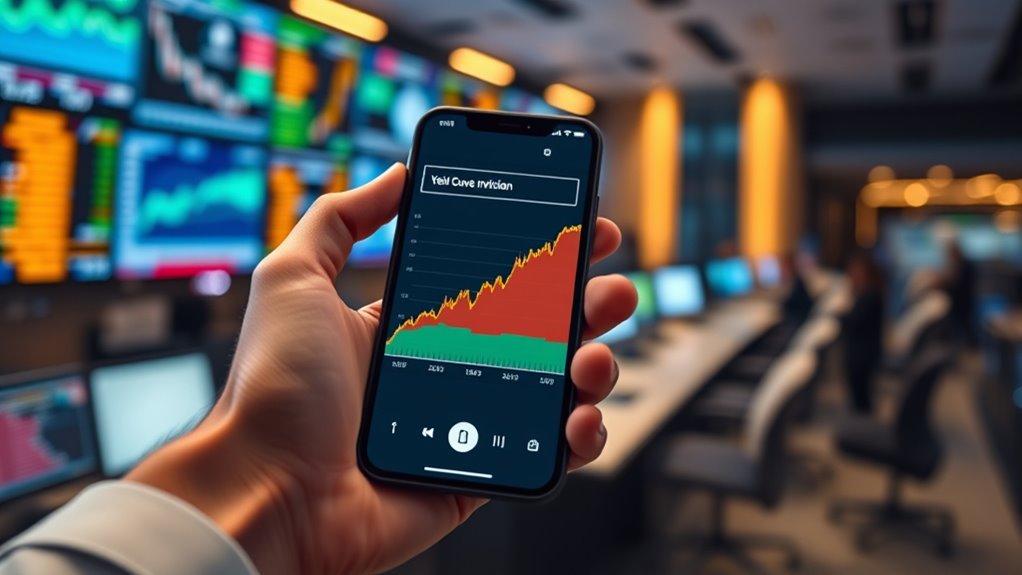A yield curve inversion happens when long-term interest rates drop below short-term ones, often signaling trouble ahead for the economy. It shows investors are worried and prefer safer, longer-term bonds, pushing their prices up and yields down. This shift suggests slower growth or a recession might be approaching. While it may seem complex, understanding the basics can help you grasp what this sign means for the economy and future developments. Keep exploring to learn more about how it works.
Key Takeaways
- An inverted yield curve happens when long-term interest rates fall below short-term rates, signaling potential economic slowdown.
- It reflects investor expectations of weaker growth or upcoming recessions, often due to rising short-term rates.
- Normally, long-term bonds have higher yields; inversion occurs when this relationship flips, indicating market concerns.
- The inversion serves as an early warning sign, showing what investors think about the economy’s future.
- While not a guarantee, a yield curve inversion has historically predicted recessions before traditional economic data signals decline.

A yield curve inversion occurs when long-term interest rates fall below short-term rates, signaling a potential shift in economic outlook. This phenomenon often catches the attention of investors and economists alike because it can indicate that a recession might be on the horizon. To understand what this means, you need to grasp how the bond market functions as a key economic indicator. The bond market is a platform where investors buy and sell debt securities, primarily government bonds, and the yields or interest rates on these bonds reflect expectations about future economic growth and inflation.
Normally, long-term bonds have higher yields than short-term bonds because investors demand a premium for locking in their money over a longer period. When long-term yields dip below short-term yields, it suggests that investors are losing confidence in the near-term economic prospects. They might be seeking the safety of longer-term bonds, which drives their prices up and yields down. At the same time, short-term interest rates might rise due to central bank policies or expectations of future rate hikes, further contributing to the inversion.
Long-term yields fall below short-term rates, signaling investor confidence wanes and economic prospects may be weakening.
You should see the yield curve as a snapshot of the bond market’s sentiment about the economy. An inverted yield curve signals that investors expect slower growth or even a downturn. It’s a powerful economic indicator because it reflects collective market sentiment about future conditions—more so than individual reports like GDP or employment figures. When the bond market shows signs of inversion, it often prompts economists and policymakers to scrutinize other economic indicators, such as manufacturing data, consumer spending, and unemployment rates, to gauge whether a slowdown is imminent.
It’s important to recognize that while a yield curve inversion doesn’t guarantee a recession, it has historically been a reliable predictor. The bond market’s behavior reveals the collective wisdom of investors, who tend to be forward-looking and more attuned to subtle shifts than some traditional economic data. thus, paying attention to these movements can give you an early warning about potential economic turbulence. Understanding the bond market and its signals isn’t about complex formulas; it’s about observing how investor sentiment shifts and recognizing what that means for the broader economy. When the yield curve inverts, it’s a sign that the bond market is signaling caution, and that’s a message worth paying attention to if you want to stay ahead of economic trends.
Frequently Asked Questions
How Often Does the Yield Curve Inversion Occur Historically?
You’re curious about how often the yield curve inverts, right? Historically, yield curve inversions happen less frequently, usually around once every 7 to 10 years. These inversion patterns often signal economic trouble ahead, often preceding recessions. While not every inversion leads to a downturn, understanding their historical frequency helps you recognize the warning signs and grasp how often these patterns emerge before economic shifts occur.
Can Individual Investors Predict Economic Downturns From the Inversion?
You can’t rely solely on the yield curve inversion to predict economic downturns, but it does influence market psychology and investor sentiment. When you see an inversion, it often signals caution or fear among investors, which can contribute to market declines. Keep in mind, while it’s a useful indicator, you should consider other economic factors and trends before making investment decisions, as no single sign guarantees an upcoming recession.
What Are the Main Differences Between Short-Term and Long-Term Bonds?
Think of bonds as musical notes—short-term bonds are quick, lively beats, while long-term bonds are deep, sustained melodies. The main difference lies in bond duration; short-term bonds have a shorter duration and are less sensitive to interest rate changes, making them safer, while long-term bonds have a longer duration, exposing you to more interest rate risk. This affects their prices and yields, guiding your investment choices wisely.
How Does the Yield Curve Inversion Affect Everyday Consumers?
A yield curve inversion can shake your confidence in the economy, leading to worries about a recession. It often signals that interest rates for short-term borrowing are higher than long-term, which can cause lenders to tighten credit. As a consumer, you might see higher borrowing costs, fewer loan approvals, and cautious spending. This shift impacts your financial plans and overall consumer confidence, making you more aware of potential economic downturns.
Are There Any Signs That Predict When the Yield Curve Will Revert?
You wonder if there are signs that predict when the yield curve will revert. Keep an eye on market indicators and economic signals, like changes in bond yields, inflation rates, and central bank policies. These clues can suggest upcoming shifts. While no single indicator guarantees a reversal, watching these signals helps you anticipate potential changes, making it easier to prepare for economic shifts and protect your finances.
Conclusion
So, now you see how a yield curve inversion signals potential economic trouble ahead. Did you know that historically, every U.S. recession in the past 60 years was preceded by an inversion? It’s like a warning sign that investors can’t ignore. By understanding this simple concept, you gain insight into the economy’s mood without needing a finance degree. Keep an eye on those bond yields—they might just tell you what’s coming next.










